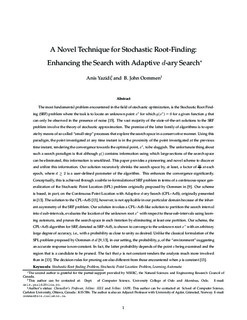| dc.description.abstract | The most fundamental problem encountered in the field of stochastic optimization and control, is the Stochastic Root Finding (SRF) problem where the task is to locate (or in the context of control, to move towards), an unknown point x* for which g(x*)=0 for a given function g that can only be observed in the presence of noise. The vast majority of the state-of-the-art solutions to the SRF problem in both stochastic optimization and control involve the theory of stochastic approximation. The premise of the latter family of algorithms is to operate by means of so-called “small-step” processes that explore the search space in a conservative manner. Instead of relying on the well-established stochastic approximation theory, we rather advocate a radically different approach that resorts to principles akin to those used in noisy Bisection Search. In deterministic Bisection Search, the main question is to determine a point x* located on a line by querying an Oracle about whether the optimal point x* lies to the left or right of a point x. A noisy version of this problem, in which the Oracle gives the correct response with probability p, was studied by Waeber and his colleagues. Inspired by the pioneering work of these authors, and its potential application in stochastic optimization and control, we map the SRF problem to a noisy Bisection Search problem where we solely use the sign information of the samples in order to guide the search.
Our solution recursively shrinks the search space by, at least, a factor of 2d3 at each epoch, where d ≥ 2 is a user-defined parameter of the algorithm. Our scheme is based, in part, on the Continuous Point Location with Adaptive d-ary Search (CPL–AdS), originally presented by Oommen and his co-authors. The solution to the CPL–AdS, however, is not applicable here because of the inherent asymmetry of the SRF problem. Our solution invokes a CPL–AdS-like solution to partition the search interval into d sub-intervals, evaluates the location of the unknown root x* with respect to these sub-intervals using Learning Automata, and prunes the search space in each iteration by eliminating at least one partition. Our scheme, the CPL–AdS algorithm for SRF, denoted as SRF–AdS, is shown to converge to the unknown root x* with an arbitrary large degree of accuracy, i.e., with a probability as close to unity as desired. | |
